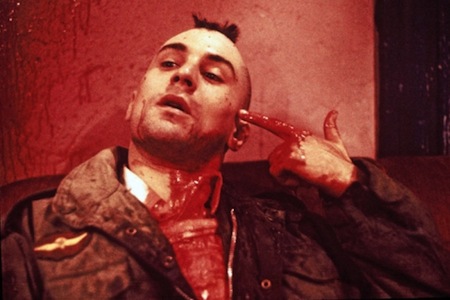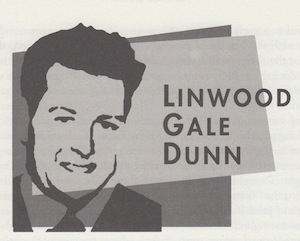Born: December 27, 1904, Brooklyn, NY
Died: May 20, 1998, Los Angeles, CA
Since 1934, there has not been a single production that did not utilize the services of the optical printer.
—Linwood Dunn
As a cameraman for RKO in 1928, Linwood Gale Dunn toyed with the idea of automating the transitions between scenes in a film. In the days of the legendary cameraman Billy Bitzer, wipes, fades and other transitions were done “in the camera,” meaning the cinematographer would hold an opaque piece of paper in front of the camera and slowly cover the lens. Dunn altered RKO’s crude optical printers so they could effect the transitions. This singular contribution would make him “the father of special effects.”
The Film 100
1. W.K. Laurie Dickson
2 Edwin S. Porter
3. Charlie Chaplin
4. Mary Pickford
5. Orson Welles
6. Alfred Hitchcock
7. Walt Disney
8. D.W. Griffith
9. Will Hays
10 Thomas Edison
11. John Wayne
12. J.R. Bray
13. Billy Bitzer
14. Jesse Lasky
15. George Eastman
16. Sergei Eisenstein
17. André Bazin
18. Irving Thalberg
19. Thomas Ince
20. Marlon Brando
21. Louis B. Mayer
22. Greta Garbo
23. Robert Flaherty
24. Lon Chaney
25. Anita Loos
26. George Méliès
27. Adolph Zukor
28. John Gilbert
29. Max Fleischer
30. John Ford
31. William Fox
32. George Lucas
33. Linwood Gale Dunn
34. Eadweard Muybridge
35. Katharine Hepburn
36. Winsor McCay
37. Stanley Kubrick
38. Buster Keaton
39. James Agee
40. Fritz Lang
41. Marcus Loew
42. Cedric Gibbons
43. James Cagney
44. Ben Hecht
45. Ingmar Bergman
46. Humphrey Bogart
47. Leon Schlesinger
48. Louella Parsons
49. Roger Corman
50. Edith Head
51. Bernard Herrmann
52. Gary Cooper
53. Mike Todd
54. Ernst Lubitsch
55. Sidney Poitier
56. Saul Bass
57. Billy Wilder
58. Bette Davis
59. Erich von Stroheim
60. Max Factor
61. Auguste and Louis Lumière
62. Woody Allen
63. Clark Gable
64. David O. Selznick
65. Gregg Toland
66. Lillian Gish
67. William Cameron Menzies
68. Lucille Ball
69. Samuel Rothafel
70. Akira Kurosawa
71. Marilyn Monroe
72. Vittorio De Sica
73. Natalie Kalmus
74. Gene Siskel and Roger Ebert
75. Willis O’Brien
76. Shirley Temple
77. Yakima Canutt
78. Sam Peckinpah
79. Jackie Coogan
80. Federico Fellini
81. Leni Riefenstahl
82. Steven Spielberg
83. Sam Warner
84. Jean-Luc Godard
85. Robert De Niro
86. Fred Astaire
87. Francis Ford Coppola
88. Ted Turner
89. Clint Eastwood
90. Dalton Trumbo
91. Dennis Hopper
92. Richard Hollingshead
93. Melvin Van Peebles
94. John Chambers
95. Mack Sennett
96. Martin Scorsese
97. Karl Struss
98. Busby Berkeley
99. John Hubley
100. John Cassavetes
The optical printer is essentially a camera aimed straight at a projector. The projector runs in precise synchronization with the camera, casting images directly onto unexposed film. To this simple apparatus, Dunn added controls to automate the fades, dissolves and wipes seen in practically every film. He skipped every other frame to speed up the action, or exposed a frame twice to give the appearance of slow motion. By filming the same image repeatedly, he made scenes freeze. His optical printers could combine shots by masking off portions of a single frame, rewinding the negatives and replacing them with others.
An additional innovation that Dunn brought to the optical printer is the use of glass cels between the camera and projector. These sheets of glass allowed Dunn to place mattes, painted sections of scenery or opaque areas to block out parts of the projected film. A typical matte shot involved projecting a scene of a car driving down a street while masking the buildings and background from the exposure. Then, Dunn would stop the camera, rewind the film, set up a reverse matte that blocked out the areas of the frame where the car traveled and project a scene of an oversized monster coming over the buildings in the background. When the film was developed, the combination of the shots would create a devastatingly realistic scene of a beast chasing fleeing motorists.
Within a few years, Linwood Dunn was the undisputed master of the optical printer and these tricky matte shots. For twenty-eight years at RKO, he honed his skills on such films as Willis O’Brien’s King Kong (1933) and Orson Welles’s Citizen Kane (1941). In fact, many of Kane’s deep-focus scenes attributed to Gregg Toland were actually created with the optical trickery of Linwood Dunn. The famous campaign scene is, in actuality, four separate shots of a crowd, a stage, a balcony and the large poster of Kane, combined under the painstaking care of Dunn and his magical equipment. Another scene required Dunn to make a shot of a nurse attending to Kane at his bedside appear as if it were reflected in the broken pieces of a fallen snow globe. Welles took to the concept of the optical printer quickly after Dunn explained its untapped artistic capabilities, and Kane has some of the finest uses of its scope.
Safety was another reason for using the special effects of the optical printer. In the film Ace of Aces (1933), Dunn combined footage of a real explosion with location shots of an aviator crawling from the cockpit of a wrecked fuselage. Through the magic of special effects, the result looked as if the pilot had made a daring last-minute escape from a burning plane. Stars Cary Grant and Katharine Hepburn couldn’t be put at risk of a leopard attack on the set of Bringing Up Baby (1938), so Dunn filmed the wild cat separately from the actors. In the final scenes, it appears that Grant and Hepburn are intimately involved with the “domesticated” feline.
When RKO folded in 1957, Dunn leased the studio’s special effect division and founded his own company, Film Effects of Hollywood, where he manufactured the Acme-Dunn, the first commercially available optical printer. Linwood Dunn offered his expertise as a consulting service to the filmmakers using his equipment. He helped establish his invention in television, actually filming the opening sequences of the space series Star Trek, in which the Enterprise ship passes quickly through space.
His expertise was instrumental in creating matte scenes for famous movie settings that never really existed. The remarkable title sequences of Robert Wise’s West Side Story (1960) were the result of collaboration between Dunn and celebrated graphic designer Saul Bass. Working together for nearly five months, they devised a 70mm print of the classic overture effects. The last scene of Stanley Kramer’s It’s a Mad, Mad, Mad, Mad World (1963) was a collection of twelve different shots, including detailed paintings of buildings, documentary footage of a busy boulevard, a burning roof and a stop-motion sequence by master animator Willis O’Brien. As the scene unfolds, there is no visible clue that it is a mixture of such disparate elements.
Dunn also freelanced for all of the major studios as Hollywood’s most celebrated fix-it man. In hundreds of movies, the optical printer saved studios costly reshoots. Martin Scorsese asked Dunn to alter the bloody shootout scene near the end of Taxi Driver (1976) to get an acceptable rating for general viewers. The scene featured a mohawked Robert De Niro executing a pimp played by Harvey Keitel. Scorsese didn’t have time or money to shoot the scene over; Dunn washed the film negative in sepia tones that muted the harsher shades of the blood, and ran the film through the optical printer to lighten certain areas. The changes passed the ratings board, and Scorsese kept the sepia-toned sequence when he restored the film for a re-release.
Dunn’s lengthy career yielded two Oscars for service and dedication to the industry. His impressive list of credits includes The Hunchback of Notre Dame (1939), The Cat People (1942), The Thing (1951), The Narrow Margin (1953), My Fair Lady (1964), The Great Race (1965), The Bible (1966), Hawaii (1966) and Airport (1970). Dunn also campaigned for a special branch of the Academy of Motion Picture Arts and Sciences to include the visual effects expert. He became their first representative and served three terms on the Academy’s board of governors. Though to his nineties, Linwood Dunn was still consulted by top directors for advice. He kept abreast of the latest trends in technology and played a significant role in the development of 3-D special effects, IMAX projection devices and digital video distribution.
Blue-screen photography was added to the features of the optical printer, and many of its principles are now accomplished with computer technology. But these new processes don’t begin to undermine the important contributions Dunn’s innovations have made to the spectacular realism of such films as Star Wars (1977). Special effects professionals thoroughly understand the incalculable value of Dunn’s formative work. Still in use today, the optical printer has evolved into an indispensable tool. It is the most vital piece of equipment ever developed for the creation of special effects.
To read all the republished articles from ‘The Film 100,’ go to Reintroducing the Film 100 here on Keyframe.





